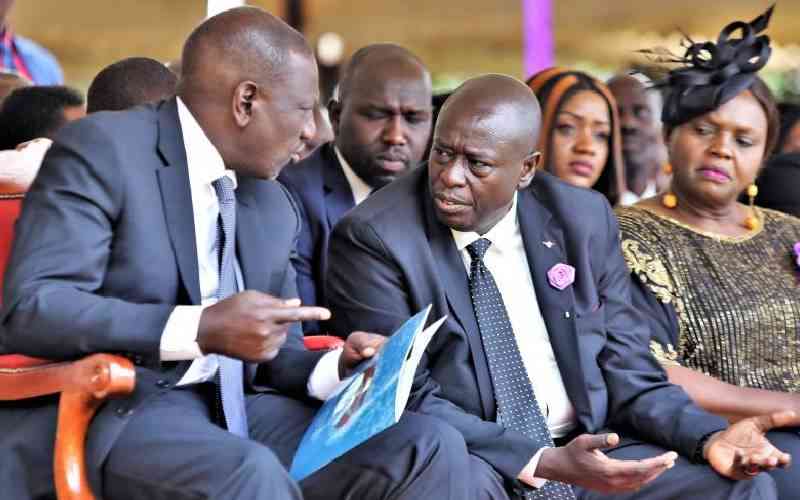
Since 2003, the Government of Kenya has committed to executing a performance-based approach to managing the public sector, introducing a series of reforms to better use resources for lasting socio-economic development. At the heart of this effort is performance contracting, which helps connect key areas of planning, budgeting, implementation, and the delivery of results that benefit citizens.
Through performance contracting, Ministries, State Departments, State Corporations, and other public sector institutions identify their key priorities as outlined in their Strategic Plans, which align with the Government's policy frameworks, including the Fourth Medium Term Plan (MTP) 2023-2027, the Bottom-Up Economic Transformation Agenda (BETA), and relevant Sessional Papers and Sector Strategies. These priorities are also reflected in the Annual Work Plans and are connected to the budget allocations for Government Ministries, Departments, and Agencies (MDAs).
The Government continues to leverage Performance Contracting to improve financial accountability and ensure the prudent use of resources in MDAs. This is achieved through results-based commitments, as well as monitoring, reporting, and evaluating financial performance across six key indicators: Absorption of Allocated Funds, Absorption of Externally Mobilized Funds, Appropriation-in-Aid (A-in-A), Pending Bills Ratio, Project Completion Rate, and Revenue Collection.
The Absorption of Allocated Funds indicator requires all MDAs to fully utilize 100 per cent of their budgeted and approved funds - whether from the Government of Kenya or generated by the MDA - on the programs, projects, and activities approved by parliament and planned at the organizational level. This ensures a clear connection between planning, budgeting, and performance. MDAs that score poorly on this indicator, indicating ineffective use of financial resources, must explain their performance and demonstrate their capacity to utilize funds in the following financial year, or risk forfeiting those resources for other programs. By mandating that MDAs use all allocated financial resources, performance contracting helps minimize waste and enables the reallocation of unspent funds to other critical areas.
Externally mobilized funds, often referred to as donor funds, play a crucial role in complementing government resources and supporting specific bilateral programs aligned with the government’s national development agenda. Effectively utilizing these funds is essential for achieving program objectives, especially since some are provided as loans that accrue interest. The performance contracting indicator for the absorption of externally mobilized funds mandates that MDAs use 100 per cent of approved funds (both loans and grants) from development partners for the programs, projects, and activities they were designated for.
Additionally, MDAs are required to disclose all sources of external funding to enhance transparency in resource management. This process is vital for ensuring the efficient use of externally mobilized funds and demonstrating the government’s commitment to fulfilling its financial obligations in donor-funded programs.
Appropriation-in-Aid (A-in-A) refers to the revenue that MDAs collect and use directly, as well as donor funds reflected as direct payments from development partners in the printed estimates. MDAs are encouraged to maximize their A-in-A collections to supplement the resources allocated from the exchequer. The performance contracting indicator for A-in-A sets targets for the amount to be collected by each MDA in a specific financial year, along with its sources. This approach reduces dependency on the exchequer for financial support, frees up resources for other programs, and enhances accountability in managing self-generated funds.
All Government Ministries, Departments, and Agencies (MDAs) must fulfil their financial obligations - both from government allocations and externally mobilized funds - by the end of the financial year. These obligations include payments for goods and services, loan repayments, and statutory deductions to relevant institutions. The pending bills ratio indicator stipulates that the unpaid commitments accrued by each MDA at the end of the financial year must not exceed 1per cent of the total budget for that year. This indicator ensures that suppliers are paid on time and that the government meets its loan obligations, which in turn stimulates economic growth, particularly in the private sector, and helps maintain a healthy credit rating.
The project completion rate indicator in the performance contract measures the percentage of planned projects that are implemented during the financial year. This assessment is based on the deliverables outlined in the project contract and the approved budget for that year. The indicator helps ensure that government projects - such as roads, dams, and buildings (including hospitals, schools, and offices)- are completed on time according to the work plans. It also addresses resource wastage and reduces the occurrence of stalled projects. Additionally, it enhances the efficiency of resource allocation by prioritizing projects that are more likely to be completed successfully.
The revenue collection indicator in the performance contract applies only to MDAs specifically mandated to collect revenue as outlined by relevant statutes. These MDAs are expected to maximize their revenue collection to support the delivery of government services. The indicator helps minimize revenue losses and enhances transparency in the revenue collection process.
In addition to the six financial management indicators highlighted before, performance contracting has mainstreamed two other financially related indicators to achieve affirmative action in accessing procurement opportunities from government institutions. These indicators are the access to government procurement opportunities indicator and the promotion of local content in the procurement indicator.
The access to government procurement opportunities indicator mandates that all MDAs allocate and award at least 30 per cent of their total procurement budget for goods and services, as outlined in the annual procurement plan, to Youth, Women, and Persons With Disabilities (PWDs), whether as individuals or organized groups. Of this 30 per cent, at least 2 per cent should be specifically reserved for PWDs. This indicator acknowledges the unique challenges that these vulnerable groups face in accessing government procurement opportunities. By reserving procurement quotas for Youth, Women, and PWDs, the indicator ensures that businesses owned by these groups have equitable access to Government contracts, thereby enhancing their capacity to participate in and benefit from larger procurements in the future.
The promotion of local content in procurement indicators requires all MDAs to allocate and award at least 40 per cent of their total procurement budget for goods and services to local producers, as outlined in each MDA's annual procurement plan. This initiative aims to enhance local producers' access to government procurement opportunities and aligns with the Government’s BUY KENYA BUILD KENYA campaign.
Ultimately, performance contracting significantly contributes to promoting efficiency and effectiveness in managing public financial resources, enhancing transparency and accountability in revenue collection, and ensuring equitable access to government procurement opportunities. The Performance Management Unit in the Office of the Deputy Chief of Staff for Performance and Delivery Management actively tracks these indicators to assess their effectiveness. Additionally, the unit periodically reviews the indicators to address challenges and respond to emerging issues in the operational environment.
Mr Owalo is the Deputy Chief of Staff for Performance and Delivery Management in the President's Executive Office
 The Standard Group Plc is a multi-media organization with investments in media
platforms spanning newspaper print operations, television, radio broadcasting,
digital and online services. The Standard Group is recognized as a leading
multi-media house in Kenya with a key influence in matters of national and
international interest.
The Standard Group Plc is a multi-media organization with investments in media
platforms spanning newspaper print operations, television, radio broadcasting,
digital and online services. The Standard Group is recognized as a leading
multi-media house in Kenya with a key influence in matters of national and
international interest.
 The Standard Group Plc is a multi-media organization with investments in media
platforms spanning newspaper print operations, television, radio broadcasting,
digital and online services. The Standard Group is recognized as a leading
multi-media house in Kenya with a key influence in matters of national and
international interest.
The Standard Group Plc is a multi-media organization with investments in media
platforms spanning newspaper print operations, television, radio broadcasting,
digital and online services. The Standard Group is recognized as a leading
multi-media house in Kenya with a key influence in matters of national and
international interest.











